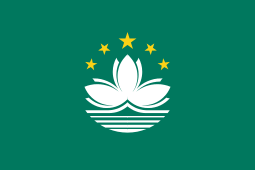United Nations geoscheme for Asia
The following is an alphabetical list of subregions in the United Nations geoscheme[1] for Asia.[2] The UNSD notes that "the assignment of countries or areas to specific groupings is for statistical convenience and does not imply any assumption regarding political or other affiliation of countries or territories".[3]
.svg.png)
Central Asia
Eastern Asia
- China (includes both the
 People's Republic of China and
People's Republic of China and  Taiwan)
Taiwan)  Hong Kong
Hong Kong Japan
Japan Macau
Macau Mongolia
Mongolia North Korea
North Korea South Korea
South Korea
Note on Taiwan
Several institutions and research papers using classification schemes based on the UN geoscheme include Taiwan separately in their divisions of Eastern Asia. (1) The Unicode CLDR's "Territory Containment (UN M.49)" includes Taiwan in its presentation of the UN M.49.[4] (2) The public domain map dataset Natural Earth has metadata in the fields named "region_un" and "subregion" for Taiwan. (3)The regional split recommended by Lloyd's of London for Eastern Asia (UN statistical divisions of Eastern Asia) contains Taiwan.[5] (4) Based on the United Nations statistical divisions, the APRICOT (conference) includes Taiwan in East Asia.[6] (5) Studying Website Usability in Asia, Ather Nawaz and Torkil Clemmensen select Asian countries on the basis of United Nations statistical divisions, and Taiwan is also included.[7] (6) Taiwan is also included in the UN Geoscheme of Eastern Asia in one systematic review on attention deficit hyperactivity disorder [8]
Southern Asia
Southeastern Asia
 Brunei Darussalam
Brunei Darussalam Cambodia
Cambodia Indonesia
Indonesia Laos
Laos Malaysia
Malaysia Myanmar
Myanmar Philippines
Philippines Singapore
Singapore Thailand
Thailand Timor-Leste
Timor-Leste Viet Nam
Viet Nam
Western Asia
See also
- United Nations geoscheme
- United Nations geoscheme for Africa
- United Nations geoscheme for the Americas
- United Nations geoscheme for Europe
- United Nations geoscheme for Oceania
References
- ↑ 구동회 ( Dong Hoe Koo ) (2013). "A Case Study on the Classification Systems of World Regions: Characteristics and Implications(세계지역구분체계에 관한 사례 연구: 특성과 함의)". National Geographic Society (formerly the Korea Institute of Geography Education) 국토지리학회(구 한국지리교육학회) (in Korean). 47 (4): 415–426. Retrieved 5 September 2015.
- ↑ Ajey Lele (20 October 2012). Asian Space Race: Rhetoric or Reality?. Springer Science & Business Media. p. 8. ISBN 978-81-322-0733-7.
The best option to identify the states from Asia could be use the United Nations (UN) geoscheme for Asia.
- ↑ Standard country or area codes and geographical regions for statistical use
- ↑ Territory Containment (UN M.49)
- ↑ Geographical diversification and Solvency II: A proposal by Lloyd’s
- ↑ Countries in APRICOT's Region
- ↑ Website Usability in Asia ‘from Within’: An Overview of a Decade of Literature International Journal of Human-Computer Interaction, vol. 29, issue 4 (2013), pp. 256-273.
- ↑ Hodgkins, Paul; Arnold, L. Eugene; Shaw, Monica; Caci, Hervé; Kahle, Jennifer; Woods, Alisa G; Young, Susan (2012). "A Systematic Review of Global Publication Trends Regarding Long-Term Outcomes of ADHD". Frontiers in Psychiatry. 2. doi:10.3389/fpsyt.2011.00084. ISSN 1664-0640. PMC 3260478
 . PMID 22279437. Retrieved 2015-09-04.
. PMID 22279437. Retrieved 2015-09-04.